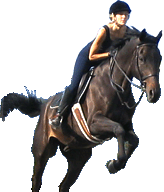|
The levels of dressage are progressive, building on the training
of the horse. Dressage riders can not talk to their horses it is
against the rules in the elegant, stylized sport where all signals
come through the hands or knees.
The dressage method of riding develops the horse mentally and physically
so that they're easier to ride.
Dressage Horse Qualities
Dressage horse should have exceptional basic paces, walk, trot and
canter along with a willing temperament. These are basic requisites
for a potential dressage horse.
Riders who have ridden dressage recognize that their own ability
is not sufficient to bring them to the top in dressage competitions,
they must also ride a quality horse. Riders that are exposed to
different types of horses, will become increasingly more proficient
as dressage riders.
Tack and Dressage
Dressage horses are shown in minimal tack. An English-style saddle
is the preferred piece of tack for riding dressage. Dressage saddles
have straight flaps on the sides to accommodate a rider's relatively
straight leg position. The dressage saddle usually has a deeper
seat than a jumping saddle, to help hold the rider in position.
However, many dressage masters shun the deep seat, believing that
a rider should not need the saddle to help them stay in place. The
dressage horse is only permitted to use a mild snaffle bit, and
the rules regarding bits vary from organization to organization.
At the lower levels of dressage, a bridle should use a plain cavesson,
drop noseband, or flash noseband.
Dressage Rider Clothing
The dressage riders clothing, like their horses, are dressed for
formality. For upper-level classes, the rider should use a shadbelly,
rather than a plain dressage coat. If the dressage rider has long
hair, it is typically worn in a hair net.
The athletic intent of dressage movements as well as their proper
execution will help increase your horse's flexibility and strength.
The rapport that develops between horse and rider exists at all
levels of Dressage. A blending of discipline, demanding work and
artistry in a harmonious partnership between horse and rider is,
perhaps, the greatest appeal of Dressage.
About the Author
Rob Daniels has been an equestrian rider for 25 years. He has studied
various disciplines additional articles are available at: Riding
Stable - http://www.riding-stable.com
and Horse Stall http://www.horse-stall.net
|


